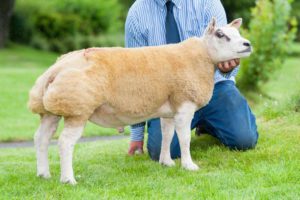Beltex genetics play an integrant role in Patrick Brolly’s farming operation near Claudy, County Londonderry, where he runs a total of 500 ewes, the majority of which are put to the Beltex ram.
Farming around 120 hectares in total alongside his father, Liam, Patrick’s flock of 70 pedigree females are joined by some 430 commercial sheep including North of England Mules and Cheviots, of which a small number are tupped with the Blueface Leicester to produce Cheviot Mules, which are then covered by Beltex rams.
Working hand in hand with the flock is a herd of 35 Stabiliser and Stabiliser cross cattle, a change from the previous Charolais-focused herd due to the Brollys looking to run a smaller type of cow on the high and heavy ground. The resulting calves are all finished at home and sold through Foyle Food Group.
On the sheep side of things, it’s the Beltex as a terminal sire that proves its worth in producing a high quality fat lamb that easily hits processors’ specifications, as well as replacement females.
“The thing about the Beltex is that they’re pretty low maintenance. The commercial ewes need little assistance at lambing and the lambs are quick to get up and sook. They’re hardy wee things too and can put up with the harsh weather we get here,” said Patrick.

Munreary Beast
Pedigree numbers have grown substantially since the first lambs were born in 1999, but it all came about by chance as Patrick explained: “I went to a sale at Portadown to buy a ram but ended up with a ewe instead and they’ve taken off since then.”
There’s a strict split when it comes to tupping and lambing times as rams run with the ewes for 20 days from 15 October onwards, before a break of two to three cycles and rams returned to the ewes. This results in roughly 300 ewes lambing from 10 March onwards with the remaining, including 100 ewe lambs all tupped by the Beltex, following in the second turn.
Subsequently, Patrick uses solely home-bred ram lambs from the March batch to cover his commercial females before they’re then offered as shearling rams the following year having proven themselves as breeders.
Proving their worth in pedigree circles, Patrick’s highs within the breed include selling a rma lamb named Munreary Beast – by Skiddaw View Trapper and out of the Topflite Real Deal-sired Munreary Signature – for an undisclosed five-figure sum to Henry Jewitt in 2016.
“Beast just had everything about him and stood out from day one for his length, power and skin,” commented Patrick.
On the show circuit, Patrick only tends to show at a select number of shows each year, including Omagh Show, Limavady Show and the Irish National at Armagh Show before it moved to Omagh. One particular highlight was claiming the Championship at the 2016 Omagh Show with the aforementioned Beast, proving he was a standout ram from the early days.
That Skiddaw View Trapper ram, which was Champion at the 2014 Royal Highland Show and later bought for 5000gns in partnership with the Harbinsons’ Glenkeen Flock, has proved to be very influential within the Munreary Flock, siring many of the top prices with multiple daughters retained.
It’s the commercial flock that is the bread and butter of the farming enterprise however, and lambs are all finished at home and sold from mid-July onwards through Sperrin Producers who have a contract with Irish Country Meats, as well as Dunbia. These early lambs are finished off grass alone and lambs are sold throughout the year with just small numbers left to hit the Easter hogg trade.
“Lambs are all hitting the E and U grades of the EUROP scale and the few Rs we get are bred from Cheviots,” said Patrick, who points out at one processor plant an extra kg of weight is paid for E grades up to 23kg, rather than the standard 22kg.
“They kill out well too with 40kg ewe lambs equating to 22kg, while ram lambs weighing 44kg kill out at 21.5kg.
“They just can’t be beaten and although its’s a few years since we’ve sold at the live auction market, buyers will always pay more for Beltex lambs as can be seen in weekly market reports,” he added.

